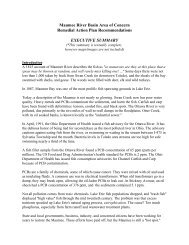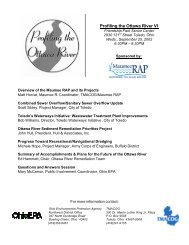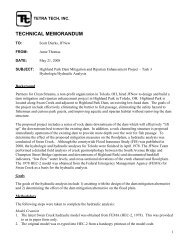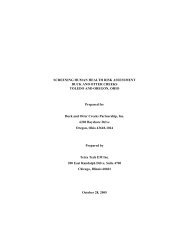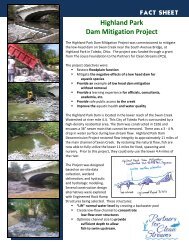Complete report - Partners for Clean Streams
Complete report - Partners for Clean Streams
Complete report - Partners for Clean Streams
Create successful ePaper yourself
Turn your PDF publications into a flip-book with our unique Google optimized e-Paper software.
prioritized areas <strong>for</strong> remediation in the Ottawa River. Results of the assessment<br />
include:<br />
• Consolidated sediment, chemical and aquatic stream data from Ohio EPA.<br />
• Analysis of PCB data according to total PCB and congener specific toxicity and<br />
identify areas with elevated PCB concentrations.<br />
• Analysis of risks to human health based on river uses and potential pathways.<br />
• Analysis of risks to ecological receptors, including fish-eating birds and mammals.<br />
• Established risk-level baseline <strong>for</strong> the lower Ottawa River.<br />
• Recommendation <strong>for</strong> priority areas <strong>for</strong> riverbed remediation.<br />
Lead Organization:<br />
Collaborator(s):<br />
TMACOG, Ohio EPA (funded in part by a grant from GLNPO) (contractor: Limnotech)<br />
Maumee RAP, Ottawa River Remediation Team<br />
Surface Water In<strong>for</strong>mation Management Systems (SWIMS)<br />
1998-Present<br />
Description:<br />
Lead Organization:<br />
The Ohio EPA Division of Surface Water has developed a client-server based<br />
Surface Water In<strong>for</strong>mation Management System (SWIMS). The system is comprised<br />
of two components. The first component is the SWIMS Central System <strong>for</strong> use by<br />
Ohio EPA staff. This component provides automation of development and tracking of<br />
NPDES permits, monitoring of permit compliance, and preparation of en<strong>for</strong>cement<br />
actions. It is planned that this system will eventually incorporate DSW’s ambient<br />
chemical and biological databases. The second component is SWIMware. This is a<br />
software package that allows the regulated community to electronically submit various<br />
permit applications and <strong>report</strong>s to the Ohio EPA Division of Surface Water.<br />
Ohio EPA<br />
Ottawa River Demonstration Capping Project<br />
September 1999 – 2000<br />
Description:<br />
The City of Toledo began a long-term sediment capping demonstration project on the<br />
Ottawa River which involved field-scale testing of AquaBlok TM , a composite material<br />
consisting of clay minerals and aggregate. AquaBlok TM was applied through the water<br />
column to physically stabilize and isolate sediments contaminated with polychlorinated<br />
biphenyls (PCBs) in a stretch of the river adjacent to Fraleigh Creek. AquaBlok TM<br />
hydrates and <strong>for</strong>ms a cohesive, low permeability, erosion resistant barrier between<br />
sediments and the overlying aquatic ecosystem.<br />
Early field monitoring results indicate that the composite material was applied<br />
successfully and is isolating the PCB-contaminated sediments effectively. Continuing<br />
surveys conducted on the encapsulated areas following construction – and through<br />
seasonal freeze-thaw and periodic high-flow conditions – indicate that AquaBlok TM<br />
stabilized and isolated impacted sediments within this study area. During this<br />
monitoring period, significant sediment deposition on top of the AquaBlok TM cap was<br />
also observed along near-bank areas. Inspection of the encapsulated areas is<br />
periodically conducted. Macroinvertebrate colonization is also being monitored.<br />
Lead Organization:<br />
City of Toledo (funded in part by a grant from Lake Erie Protection Fund)<br />
Activities and Accomplishments<br />
in the Maumee Area of Concern<br />
187<br />
Issue 8: Contaminated<br />
Stream Sediments



